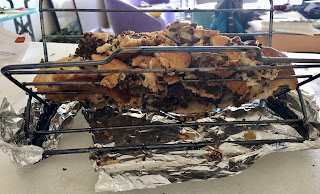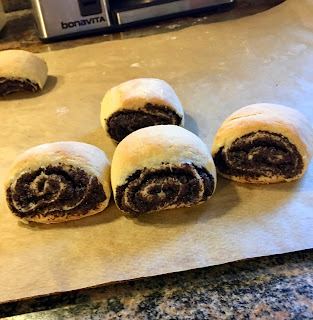

In February, two days after
my mother died, I called the spiritual care counselor from the Hospice team, just to talk a little.
She is what used to be called a chaplain. My mother got to know her several years before entering hospice care. She is a warm and open-minded woman, a little younger than I. We shared a liberal Protestant background that had shifted for both of us--in her case, into something more broadly spiritual and harder to categorize. She appreciated my mother's feisty spirit. And she continued to visit even as the cloud of dementia settled over her.
It helped me to talk to the counselor. But I was caught off guard when she asked whether the family had "made any plans" for later in the week.
I had just told her how touched I was that our sons, who live in New York and Toronto, had decided to fly to California to spend the rest of the week with us. My mother hadn't wanted a traditional funeral. We hoped to have a family gathering and scattering of ashes at a botanic garden in Chicago, where my sister and her family still lived. But that wouldn't happen until the summer.
The counselor kept nudging. But what about this week?
I assured her that we would have at least one dinner with my brother, who also lives in the San Francisco Bay area. We always do that when our sons visit. My sister and her husband had recently spent almost a week with us, earlier in the month, around the time of our mother's ninety-fifth birthday. So we had all been together recently, even if the visits had been spread out.
 |
| February 1st, 95th Birthday Flowers |
The counselor thought something more was needed. When someone dies, she believed, the family needs to "gather with intention." It might be for a ceremony, a religious ritual, or simply a special dinner. What actually happens is less important than making a commitment to be together, in order to mark the passing of the loved one.
I realized this wise woman was probably right. I picked a date for the family dinner: Friday, three days away. I told my husband, the boys and my brother. I told my sister, just in case she and her husband could fly back to join us.
And I requested that everyone contribute something, food or drink, that we associated with my mother.
The result was an eclectic dinner, built around family favorites from different seasons of our lives. Rooted in a simpler time and reflective of a certain mid-century middle American sensibility, with a few European flourishes.
This was not haute cuisine. Sour cream onion dip served with potato chips. A collapsed Bisquick meat roll that never made it to the table. Waldorf salad and spanakopita. Tapioca pudding and poppy seed kifli. A once-popular Portuguese wine.
But every bite, every sip, evoked memories of the past, along with a complicated mix of feelings. Love and loss. Relief and regret. Nostalgia and laughter. The honey on the thorn, as the once-famous Slovenian writer Louis Adamic would have called it.
As we sat down to dinner, one of our sons proposed a toast, his glass filled with the special Spanish sparkling wine my mother preferred for festive occasions.
"To Grandma," he said.
To my mother.
To Alice.
 |
My mother (second from left) and her friends,
Kent State University, near Cleveland, 1941 |
A Nostalgic Dinner To Remember My Mother
Wines: Mateus Rosé and Freixenet
Potato Chips with Sour Cream Onion Dip
Failed Bisquick Meat Roll
Spanakopita (Greek Spinach Cheese Pie)
Waldorf Salad on Lettuce
Tapioca Pudding
Poppy Seed Kifli
For their contributions to the meal, my husband and sons immediately thought of wine.
For my husband, the choice was clear: Mateus Rosé. When he first met my family, this was one of the two "fancy wines" (the other was Lancer's) that my parents served for special dinners. They weren't alone. In the early 1970s, according to
this recent article, this was the most popular wine in the world. Although a wine snob might be dismissive, these days some experts think the time might be ripe for a Mateus revival.
My mother loved that wine, probably because it tasted sweet and looked elegant in the distinctive round glass bottle. She always stumbled over the pronunciation of the Portuguese name, which came out sounding like Matt'-ee-us. When my husband and I got married in my parents' backyard, this was the wine the rabbi offered us during the ceremony, from that small green bottle in the photo below.
Our sons selected another family wine classic, from a slightly later era: Freixenet--or "bubbly," as my mother often called it, perhaps to circumvent the tricky pronunciation. My parents' discovery of this affordable alternative to champagne wasn't just a lucky accident. In the 1970s, the Spanish winemaker began to promote it with a series of ads featuring celebrities. By the 1980s, Freixenet had become the world's most popular sparkling wine, according to the
company website.
To accompany the pre-dinner wine, I decided to offer another vintage favorite: Potato chips with that ever-popular dip created by mixing sour cream with a packet of onion soup mix, assuming such a thing still existed. I was amused to discover that our local natural foods grocery carried a product that looked just like the soup base I remembered but dropped any pretense about the intended use. It was clearly marked as an all-natural organic onion dip mix. I thought it was tasty, although no one else seemed especially eager to indulge in this guilty pleasure.
I wasn't sure what my brother planned to contribute. I found out late that morning, when he e-mailed a photo of his attempt at a childhood favorite from our early Cleveland days: Bisquick Meat Roll. Unfortunately, the loaf collapsed when he removed it from the oven. (I don't know what he was doing with that folding rack, since our mother always baked and served this homey concoction from a flat baking pan.) I thought it could be salvaged as a casserole. From a distance, my sister thought it looked "yummy," like a meaty bread pudding. But my brother didn't think it would survive the journey on the train, so he left it at home.
Fortunately, I had already decided on another main course: Spinach cheese pie. But instead of
zeljanica, the ex-Yugoslav version I'd been making lately, I wanted to return to Greek spanakopita. That festive party dish became a favorite in my family in the 1960s, after we moved from Cleveland to Chicago, where there was a thriving Greek community and a popular West Loop restaurant district known as Greektown.
I looked for an easy but authentic recipe and found
this one, with an uncooked filling the blogger described as "quick and dirty." It was a simple mixture of thawed frozen spinach, eggs, feta cheese, fresh parsley, dill, and chopped onion, with olive oil instead of melted butter used to brush the phyllo leaves. It turned out well. Just as I recalled, Greek spanakopita is denser, less custardy, and more aromatic than zeljanica.
For the salad course, I picked my mother's favorite: Waldorf salad, so sweet and rich that it could double as dessert. My mother was a true connoisseur. She considered dates an essential ingredient and always threatened to talk to the chef when the restaurant at her retirement community "forgot" them. We grew up on her version: Cubed McIntosh apples and bits of dates, combined with crunchy walnuts and slices of celery, and then bound together with generous amounts of Kraft's Miracle Whip salad dressing.
The
original recipe, created by a Swiss chef at New York's Waldorf-Astoria in 1896, was more minimalist than than any of us realized: Just apples, celery, and mayonnaise, served over lettuce. It quickly became an American classic. It even shows up in my vintage Slovenian American cookbooks. For this dinner, I made it my mother's way, but with a few twists: toasted walnuts, real mayonnaise with a touch of pomegranate syrup, served on a bed of romaine lettuce. I was surprised at how tasty it was.
For dessert, I resurrected another old-fashioned favorite my mother loved. Tapioca pudding. My mother always made the fluffy version, from the recipe on the red Kraft Minute Tapioca box. I used to watch her pour the warm eggy custard into the big yellow pyrex bowl of stiffly beaten egg whites and carefully fold everything together. As a special treat, we got to sample a spoon or two while it was still warm. It might be nursery food, but it was wonderful.
As a child, it never occurred to me to worry about those little white globules of uncooked meringue bobbing in the golden yellow pudding. By current standards, however, it struck me as a little risky. So I was relieved to discover that the current Kraft recipe for
Fluffy Tapioca Cream does it the other way around, by stirring the beaten egg whites into the warm custard. Timid cooks might want to do this on the stove, so the mixture continues to cook. This newer method resulted in a pudding that was a little smoother and lighter, and every bit as delicious as I remembered.
I never considered making
potica for our memorial dinner.
It just didn't feel right. I didn't have the time or energy. Or perhaps it was too soon to make something that was so intimately tied to my mother. And she only baked potica at Christmas.
But I did want to include something of her Slovenian heritage. So I decided to bake some yeast kifli,
a recent discovery that I had dubbed "potica babies" because they reminded me of miniature versions of our treasured holiday bread. Since I was pressed for time, I decided to look for a food processor version. I found a recipe, much like the one I had made twice before, except for the addition of a little sugar in the dough.
Strangely, these short-cut kifli, prepared at a time when I felt so sad and preoccupied, were the most successful yet.
I think my mother would have liked these delicate little pastry-cookies, even with poppy seeds in the filling instead of walnuts. (In true potica, of course, that would have been an unacceptable lapse!)

















